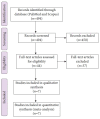Use of abdominal compression device in colonoscopy: a systematic review and meta-analysis
- PMID: 37231649
- PMCID: PMC10393576
- DOI: 10.5946/ce.2022.304
Use of abdominal compression device in colonoscopy: a systematic review and meta-analysis
Abstract
Background/aims: Colonoscopy for screening is associated with unpleasant experiences for patients, and abdominal compression devices have been developed to minimize these problems. However, there is a paucity of data supporting the therapeutic benefits of this strategy. This study examined the effects of using an abdominal compression device during colonoscopy on the cecal intubation time (CIT), abdominal compression, patient comfort, and postural changes.
Methods: We searched PubMed and Scopus (from inception to November 2021) for randomized controlled trials that assessed the effects of an abdominal compression device during colonoscopy on CIT, abdominal compression, patient comfort, and postural change. A random-effects meta-analysis was performed. Weighted mean differences (WMDs) and Mantel-Haenszel odds ratios (ORs) were calculated.
Results: Our pooled analysis of seven randomized controlled trials revealed that abdominal compression devices significantly reduced CIT (WMD, -0.76 [-1.49 to -0.03] minutes; p=0.04), abdominal compression (OR, 0.52; 95% confidence interval [CI], 0.28-0.94; p=0.03), and postural changes (OR, 0.46; 95% CI, 0.27-0.78; p=0.004) during colonoscopy. However, our results did not show a significant change in patient comfort (WMD, -0.48; 95% CI, -1.05 to 0.08; p=0.09) when using an abdominal compression device.
Conclusion: Our findings demonstrate that employing an abdominal compression device may reduce CIT, abdominal compression, and postural change but have no impact on patient comfort.
Keywords: Cecum; Colonoscopy; Equipment and supplies; Intubation, gastrointestinal.
Conflict of interest statement
The authors have no potential conflicts of interest.
Figures





Similar articles
-
Use of an abdominal binder in colonoscopies performed by trainees in gastrointestinal endoscopy: a randomized, double-blind, sham-controlled trial.Surg Endosc. 2025 May;39(5):3236-3246. doi: 10.1007/s00464-025-11710-8. Epub 2025 Apr 14. Surg Endosc. 2025. PMID: 40229596 Clinical Trial.
-
Effects of Encircled Abdominal Compression Device in Colonoscopy: A Meta-Analysis.J Clin Med. 2019 Dec 19;9(1):11. doi: 10.3390/jcm9010011. J Clin Med. 2019. PMID: 31861574 Free PMC article. Review.
-
The impact of abdominal compression devices on colonoscopy outcomes: a systematic review and meta-analysis of randomized controlled trials.Curr Med Res Opin. 2023 Sep;39(9):1247-1256. doi: 10.1080/03007995.2023.2243214. Epub 2023 Aug 18. Curr Med Res Opin. 2023. PMID: 37526014
-
A Novel Hands-Free Abdominal Compression Device for Colonoscopy Significantly Decreases Cecal Intubation Time: A Prospective Single-Blinded Pilot Study.J Laparoendosc Adv Surg Tech A. 2017 Jun;27(6):564-570. doi: 10.1089/lap.2016.0649. Epub 2017 Apr 4. J Laparoendosc Adv Surg Tech A. 2017. PMID: 28375709 Clinical Trial.
-
Use of an Abdominal Compression Device in Colonoscopy: A Randomized, Sham-Controlled Trial.Clin Gastroenterol Hepatol. 2016 Jun;14(6):850-857.e3. doi: 10.1016/j.cgh.2015.12.039. Epub 2016 Jan 6. Clin Gastroenterol Hepatol. 2016. PMID: 26767313 Free PMC article. Clinical Trial.
Cited by
-
Use of an abdominal binder in colonoscopies performed by trainees in gastrointestinal endoscopy: a randomized, double-blind, sham-controlled trial.Surg Endosc. 2025 May;39(5):3236-3246. doi: 10.1007/s00464-025-11710-8. Epub 2025 Apr 14. Surg Endosc. 2025. PMID: 40229596 Clinical Trial.
References
-
- Nishizawa T, Suzuki H, Takahashi M, et al. Trainee participation during colonoscopy adversely affects polyp and adenoma detection rates. Digestion. 2011;84:245–246. - PubMed
-
- Ignjatovic A, East JE, Suzuki N, et al. Optical diagnosis of small colorectal polyps at routine colonoscopy (Detect InSpect ChAracterise Resect and Discard; DISCARD trial): a prospective cohort study. Lancet Oncol. 2009;10:1171–1178. - PubMed
LinkOut - more resources
Full Text Sources

